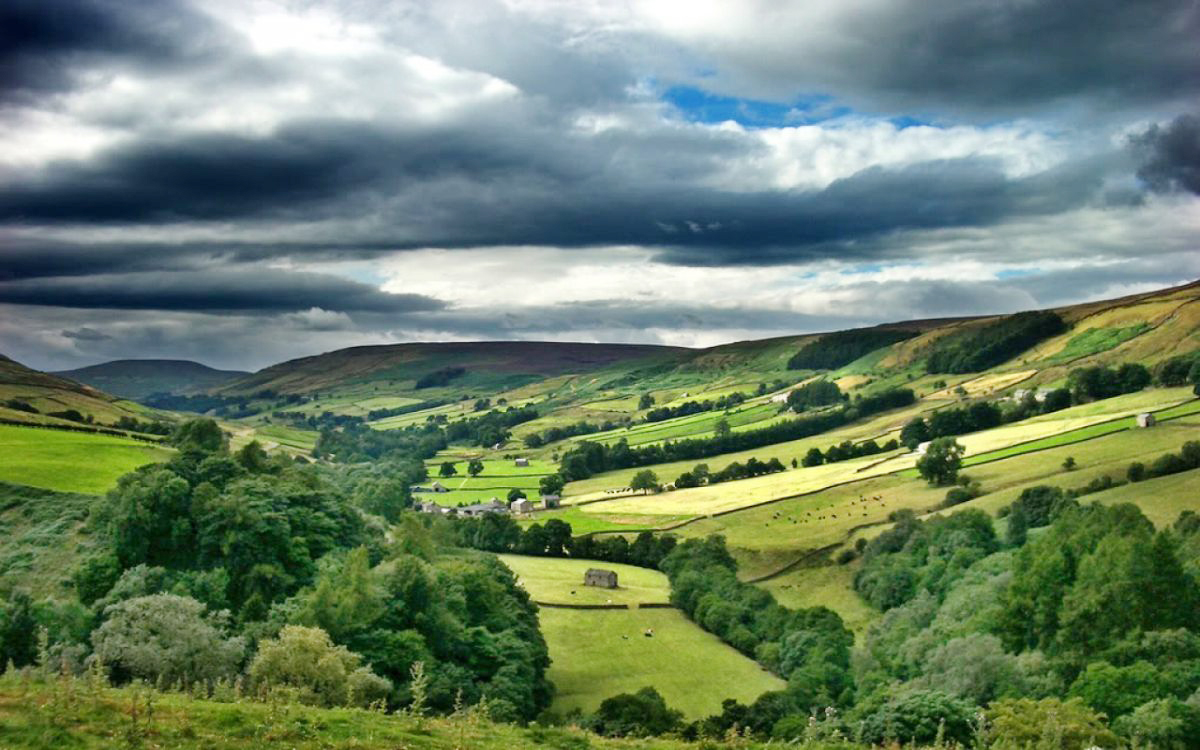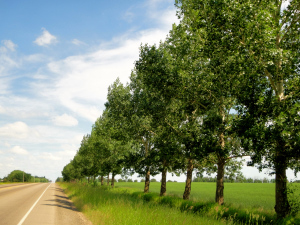by Donald Craig, 2019 Celestial Planting Calendar
Shortly after humans started clearing forests for agriculture, they found it necessary to plant windbreaks to compensate for the benefits lost by the removal of the forests.
Some of those benefits include:
• Protection of buildings due to slowing down of winter winds;
• Reduction of both soil and water erosion;
• Control of snow accumulation around buildings
and along roadways;
• Provision of habitats for birds and predator insects who
control infestations of crop-eating insects;
• Increase of crop yields;
• Production of food and other harvestable products.
In Ontario, most of us have seen windbreaks of spruce or cedar, which were planted around houses and sometimes entire farmsteads in the late 19th and early 20th centuries. Those windbreaks were planted to reduce heating costs and to make houses more comfortable in the winter. We all know from listening to weather reports that the wind chill factor significantly increases the heat loss from our bodies and our homes. Wind- breaks were planted around the west and north sides and less frequently along the east sides of buildings to reduce that wind chill factor.
 As these windbreaks matured, it was discovered that they collected snow. In the prairies, this was convenient because any snow that stayed on a farmer’s land provided water for his crops the following summer. In Ontario, this is not considered as much of a benefit because we generally receive sufficient precipitation in the growing season. However, one useful benefit is the fact that accumulation of snow along a windbreak takes longer to melt; they stretch out spring water flows over a longer period of time, and this process lowers the flood peak. As these windbreaks matured, it was discovered that they collected snow. In the prairies, this was convenient because any snow that stayed on a farmer’s land provided water for his crops the following summer. In Ontario, this is not considered as much of a benefit because we generally receive sufficient precipitation in the growing season. However, one useful benefit is the fact that accumulation of snow along a windbreak takes longer to melt; they stretch out spring water flows over a longer period of time, and this process lowers the flood peak.
Wherever windbreaks accumulate snow in temperate climates, they can be either convenient or inconvenient depending on the design, the species of trees used, the location of nearby buildings, and laneways, as well as their stage of development. The old slat-and-wire “Canadian” snow fence was designed and installed by road maintenance crews to slow the wind and deposit snow before it reached the road surface. Then, they discovered that as the wind picked up speed approaching the road, it had a tendency to pick up snow rather than deposit it. This artificial snow fence wind-break has a 50 percent porosity.
When living windbreaks of cedar or spruce are planted too close to the road and provide close to 50 percent porosity, they also accumulate snow downwind and can dump snow on lanes or roadways. As time goes on and the limbs touch each other, the porosity drops to 40 or 30 percent or less, and the snow starts to accumulate on the upwind side of the windbreak. Later as some of the bottom limbs die off, snow starts to accumulate on the roadway again and it becomes necessary to prune all the bottom branches two to three meters above the ground to allow the wind to carry the snow off the road.
I think most people are aware that windbreaks help reduce soil erosion. However, few people know that we once had deserts of blowing sand in Ontario from the late 19th to mid-20th century. This was caused by clear cutting the native forest. Under agreements between local municipalities and the Province of Ontario, larger as well as smaller tracts of land, including what is now the Larose forest, the Ganaraska forest, the Northumberland forest, the Norfolk County forest and the Simcoe County forest, were replanted by the provincial forestry department. Other sand dunes were controlled by planting windbreaks and remained as working farms.
Windbreaks planted on the contours or across slopes reduce water-related soil erosion and subsequent siltation of nearby streams, ponds, lakes and rivers.
At the beginning of the industrial revolution, the agricultural industry was in trouble in Great Britain. Yields were so low that it was not worthwhile to plant crops. Many properties were purchased by nouveau-rich industrialists and turned into vast show gardens. One of the discoveries made was that the hedgerows that were planted for flowers and beautiful foliage increased crop yields in adjacent fields. This was primarily because the birds and predator insects living in the hedgerows controlled the previously uncontrolled insect pests.
Research has been done all over the world—in temperate as well as tropical climates—to determine the effects of windbreaks on crop yields. Whether it is fruit crops, such as apples or strawberries, or underground crops, such as potatoes and peanuts, or field crops, such as wheat, corn or beans, the results are the same—windbreaks increase crop yields.
Dr. Charles Baldwin from Ridgetown College of Agricultural Technology (now called the University of Guelph Ridgetown Campus) showed crop increases on both sides of windbreaks, which more than compensated for the land they occupied and the few adjacent rows of crops where the yield was reduced. The yield loss extended out one half of the height of the windbreak. From there out to 10 times the height of the windbreak, the yields were above the field average. He subtracted the yield loss where the trees were and the loss out to half the windbreak height and found an average net gain of 7 percent yield on one side and a 15 percent increase in yield on the other side. More recently, people with yield monitors on their combines have noticed an increase of between 0.5 and 10 times the height of a windbreak or woodlot. Unfortunately some people see the low crop yield in the first few rows beside the windbreak and assume that the increase in crop yield further out is in spite of the windbreak not because of it.
 There is no perfect species for windbreaks. Nor is there a perfect spacing or porosity. On the prairies, where water is restricted and growth rates as well as ultimate size are limited, several rows are often planted. In Ontario, we often plant a single row of spruce or cedar around a house where we want to slow down the wind as much as possible. A second row planted 20 to 30 feet from the first may be advisable, but for crop-yield increases and reduced soil erosion, even a single row of cedar, spruce or deciduous species may be too dense. It turns out that the more we reduce the wind speed on the downwind side of a windbreak, the sooner it gets back up to full speed again. For both wind erosion and crop yield increases, a porosity of 40 to 60 percent is adequate. There is no perfect species for windbreaks. Nor is there a perfect spacing or porosity. On the prairies, where water is restricted and growth rates as well as ultimate size are limited, several rows are often planted. In Ontario, we often plant a single row of spruce or cedar around a house where we want to slow down the wind as much as possible. A second row planted 20 to 30 feet from the first may be advisable, but for crop-yield increases and reduced soil erosion, even a single row of cedar, spruce or deciduous species may be too dense. It turns out that the more we reduce the wind speed on the downwind side of a windbreak, the sooner it gets back up to full speed again. For both wind erosion and crop yield increases, a porosity of 40 to 60 percent is adequate.
Most people seem to think we need coniferous species because they are dense all year round. In the case of crop yields, most crops are only growing during the period when the leaves are on deciduous trees, so these trees are just as effective for field windbreaks as the coniferous species. Moreover, deciduous trees located on the southern exposures of homes provide shade and coolness in the summer but enable the sun to heat the homes to some degree in the winter.
Donald Craig is a registered Professional Forester who has spent over 30 years designing and planting windbreaks, and advising land owners on how to manage them. He remembers planting his first tree in 1969 near London, Ontario. Several years ago, he took his grandchildren back to that same area, which is now called the Shetland Conservation Area.
|


![]()

 As these windbreaks matured, it was discovered that they collected snow. In the prairies, this was convenient because any snow that stayed on a farmer’s land provided water for his crops the following summer. In Ontario, this is not considered as much of a benefit because we generally receive sufficient precipitation in the growing season. However, one useful benefit is the fact that accumulation of snow along a windbreak takes longer to melt; they stretch out spring water flows over a longer period of time, and this process lowers the flood peak.
As these windbreaks matured, it was discovered that they collected snow. In the prairies, this was convenient because any snow that stayed on a farmer’s land provided water for his crops the following summer. In Ontario, this is not considered as much of a benefit because we generally receive sufficient precipitation in the growing season. However, one useful benefit is the fact that accumulation of snow along a windbreak takes longer to melt; they stretch out spring water flows over a longer period of time, and this process lowers the flood peak.  There is no perfect species for windbreaks. Nor is there a perfect spacing or porosity. On the prairies, where water is restricted and growth rates as well as ultimate size are limited, several rows are often planted. In Ontario, we often plant a single row of spruce or cedar around a house where we want to slow down the wind as much as possible. A second row planted 20 to 30 feet from the first may be advisable, but for crop-yield increases and reduced soil erosion, even a single row of cedar, spruce or deciduous species may be too dense. It turns out that the more we reduce the wind speed on the downwind side of a windbreak, the sooner it gets back up to full speed again. For both wind erosion and crop yield increases, a porosity of 40 to 60 percent is adequate.
There is no perfect species for windbreaks. Nor is there a perfect spacing or porosity. On the prairies, where water is restricted and growth rates as well as ultimate size are limited, several rows are often planted. In Ontario, we often plant a single row of spruce or cedar around a house where we want to slow down the wind as much as possible. A second row planted 20 to 30 feet from the first may be advisable, but for crop-yield increases and reduced soil erosion, even a single row of cedar, spruce or deciduous species may be too dense. It turns out that the more we reduce the wind speed on the downwind side of a windbreak, the sooner it gets back up to full speed again. For both wind erosion and crop yield increases, a porosity of 40 to 60 percent is adequate.